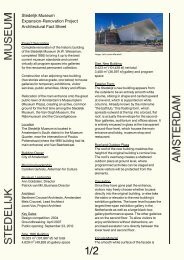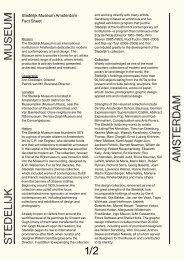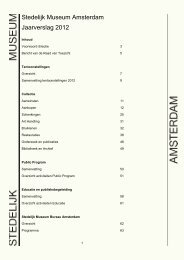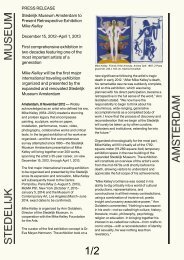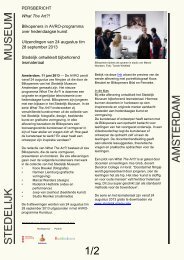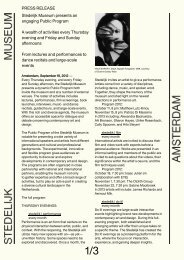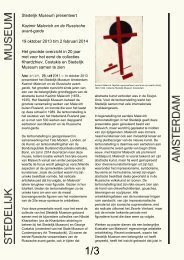Stedelijk Museum Annual Report 2012
Stedelijk Museum Annual Report 2012
Stedelijk Museum Annual Report 2012
You also want an ePaper? Increase the reach of your titles
YUMPU automatically turns print PDFs into web optimized ePapers that Google loves.
Education<br />
Overview<br />
After months of developing plans for new programs and public spaces, and<br />
recruiting and training volunteers, tour guides, and Blikopeners, the moment finally<br />
arrived: the opening. It was a day the Education Department had long been<br />
anticipating.<br />
In <strong>2012</strong>, response to the museum’s educational activities was overwhelming. Many<br />
thousands of students, families, and young people flocked to the reopened <strong>Stedelijk</strong><br />
<strong>Museum</strong>. For some it was their first visit, for others an exciting opportunity to see<br />
the building and beloved icons of the collection in a new light. Visitors took part in<br />
interactive tours and activities, exploring the historic building, the new wing, works<br />
from the collection, and temporary exhibitions.<br />
A total of 9,791 students visited the museum during a span of three months. They<br />
explored the museum on their own, took a custom guided tour, or participated in<br />
one of the 20 education programs, often taking a workshop in one of the new<br />
education studios. The special <strong>Stedelijk</strong> pass for teachers allowed education<br />
professionals free admission to the museum, which they took advantage of either to<br />
prepare classes or seek inspiration. This year, the Education Department was an<br />
inspiring and fertile learning and working environment for seven interns and seven<br />
MAS placements (secondary school students who perform some 30 hours of<br />
volunteer service as part of their school curriculum).<br />
Families<br />
In the reopened museum, there are more activities than ever for families to enjoy.<br />
Family trails, guided tours for families (which attracted 225 participants), and an<br />
interactive family audio tour with visuals invite visitors to look at and talk about art<br />
together. Families now have a space of their own, the Family Lab designed by Niels<br />
van Eijk and Miriam van der Lubbe, located beneath the famous grand staircase in<br />
the historic building. The Family Lab is a place for families to get to grips with<br />
questions such as, “What is movement” They can watch a video or take part in<br />
hands-on activities. Families and other visitors with children are welcome to visit the<br />
Family Lab throughout the day.<br />
Children’s Workshops Given by Artists<br />
Every Sunday afternoon in <strong>2012</strong>, the museum’s two brand new workshop rooms<br />
played host to activities for curious visitors between the ages of 6 and 12. Artists<br />
and designers such as Jasper Krabbé, Job Koelewijn, Floortje Zonneveld, and Jan<br />
Rothuizen gave 15 unique workshops here. They provided inspiration to the 285<br />
children who participated and were in turn inspired. Writing in the November 14<br />
edition of het Parool about the workshops he gave, Jasper Krabbé says: “Children<br />
have unbridled powers of imagination. For them, reality is a magical realm. And the<br />
red goat, the woman with the floating head or man with seven fingers in the painting<br />
by Marc Chagall are completely normal. And there is nothing at all strange about<br />
Picasso’s lady wearing a fish for a hat.”<br />
For Young Children: Atelier of Light<br />
During the Christmas holiday, more than 4,900 people visited the Atelier of Light in<br />
the education workshop rooms of the <strong>Stedelijk</strong>. Young children were given the time<br />
and space to explore the many facets of light from projection to phosphorescence,<br />
and color mixing to color splitting. The atelier was a collaborative project bringing<br />
together art and science and offered children an opportunity to experiment and form<br />
hypotheses, create compositions, question their own and other people’s ideas about<br />
light, and talk about it. The assistants on hand encouraged the children to<br />
experiment and arrive at their own conclusions.<br />
Elementary Schools<br />
57



